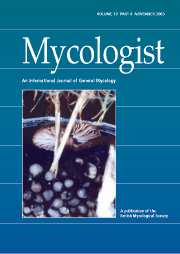Crossref Citations
This article has been cited by the following publications. This list is generated based on data provided by
Crossref.
La Porta, N.
Capretti, P.
Thomsen, I. M.
Kasanen, R.
Hietala, A. M.
and
Von Weissenberg, K.
2008.
Forest pathogens with higher damage potential due to climate change in Europe.
Canadian Journal of Plant Pathology,
Vol. 30,
Issue. 2,
p.
177.
Ostry, M.E.
and
Anderson, N.A.
2009.
Genetics and ecology of the Entoleuca mammata-Populus pathosystem: Implications for aspen improvement and management.
Forest Ecology and Management,
Vol. 257,
Issue. 2,
p.
390.
Galantinho, Ana
and
Mira, António
2009.
The influence of human, livestock, and ecological features on the occurrence of genet (Genetta genetta): a case study on Mediterranean farmland.
Ecological Research,
Vol. 24,
Issue. 3,
p.
671.
Pažoutová, Sylvie
Šrůtka, Petr
Holuša, Jaroslav
Chudíčková, Milada
and
Kolařík, Miroslav
2010.
The phylogenetic position of Obolarina dryophila (Xylariales).
Mycological Progress,
Vol. 9,
Issue. 4,
p.
501.
Tubby, K. V.
and
Webber, J. F.
2010.
Pests and diseases threatening urban trees under a changing climate.
Forestry,
Vol. 83,
Issue. 4,
p.
451.
Kowalski, T.
and
Andruch, K.
2012.
Mycobiota in needles ofAbies albawith and without symptoms of Herpotrichia needle browning.
Forest Pathology,
Vol. 42,
Issue. 3,
p.
183.
Martín-García, Jorge
Müller, Michael M.
and
Diez, Julio Javier
2012.
ITS-based comparison of endophytic mycota in twigs of native Populus nigra and cultivated P. x euramericana (cv. I-214) stands in Northern Spain.
Annals of Forest Science,
Vol. 69,
Issue. 1,
p.
49.
Linnakoski, Riikka
Puhakka-tarvainen, Helena
and
Pappinen, Ari
2012.
Endophytic fungi isolated from Khaya anthotheca in Ghana.
Fungal Ecology,
Vol. 5,
Issue. 3,
p.
298.
Vasilyeva, L. N.
Stephenson, S. L.
Hyde, K. D.
and
Bahkali, A. H.
2012.
Some stromatic pyrenomycetous fungi from northern Thailand - 1. Biscogniuxia, Camillea and Hypoxylon (Xylariaceae).
Fungal Diversity,
Vol. 55,
Issue. 1,
p.
65.
Vanegas Berrouet, Katherine Maritza
Gutiérrez Sánchez, Pablo Andrés
and
Marín Montoya, Mauricio Alejandro
2014.
Molecular Identification of Fungi Isolated from Bean Tissues with Anthracnose Symptoms.
Acta Biológica Colombiana,
Vol. 19,
Issue. 2,
p.
143.
Silva-Hughes, Alice F.
Wedge, David E.
Cantrell, Charles L.
Carvalho, Camila R.
Pan, Zhiqiang
Moraes, Rita M.
Madoxx, Victor L.
and
Rosa, Luiz H.
2015.
Diversity and antifungal activity of the endophytic fungi associated with the native medicinal cactus Opuntia humifusa (Cactaceae) from the United States.
Microbiological Research,
Vol. 175,
Issue. ,
p.
67.
Koukol, O.
Kelnarová, I.
Černý, K.
and
Woodward, S.
2015.
Recent observations of sooty bark disease of sycamore maple in Prague (Czech Republic) and the phylogenetic placement of Cryptostroma corticale.
Forest Pathology,
Vol. 45,
Issue. 1,
p.
21.
Bendixsen, Devin P.
Hallgren, Stephen W.
and
Frazier, Amy E.
2015.
Stress factors associated with forest decline in xeric oak forests of south-central United States.
Forest Ecology and Management,
Vol. 347,
Issue. ,
p.
40.
Zabalgogeazcoa, I.
Pedro, J.
Canals, R. M.
and
Sieber, T.
2015.
Biscogniauxia nummularia infecting beech (Fagus sylvatica) trees and sympatric plants of the sedge Carex brevicollis.
Forest Pathology,
Vol. 45,
Issue. 4,
p.
346.
Luchi, Nicola
Capretti, Paolo
Pazzagli, Mario
and
Pinzani, Pamela
2016.
Powerful qPCR assays for the early detection of latent invaders: interdisciplinary approaches in clinical cancer research and plant pathology.
Applied Microbiology and Biotechnology,
Vol. 100,
Issue. 12,
p.
5189.
Luchi, N
Capretti, P
Feducci, M
Vannini, A
Ceccarelli, B
and
Vettraino, AM
2016.
Latent infection of Biscogniauxia nummularia in Fagus sylvatica: a possible bioindicator of beech health conditions.
iForest - Biogeosciences and Forestry,
Vol. 9,
Issue. 1,
p.
49.
Raimondo, Maria Luisa
Lops, Francesco
and
Carlucci, Antonia
2016.
Charcoal Canker of Pear, Plum, and Quince Trees Caused by Biscogniauxia rosacearum sp. nov. in Southern Italy.
Plant Disease,
Vol. 100,
Issue. 9,
p.
1813.
Moroni, M.T.
Musk, R.
and
Wardlaw, T.J.
2017.
Forest succession where trees become smaller and wood carbon stocks reduce.
Forest Ecology and Management,
Vol. 393,
Issue. ,
p.
74.
Ghanbary, E.
Tabari Kouchaksaraei, M.
Mirabolfathy, M.
Modarres Sanavi, S. A. M.
Rahaie, M.
and
Scanu, B.
2017.
Growth and physiological responses of Quercus brantii seedlings inoculated with Biscogniauxia mediterranea and Obolarina persica under drought stress.
Forest Pathology,
Vol. 47,
Issue. 5,
Fernandes, G. Wilson
Oki, Yumi
Belmiro, Michel Stórquio
Resende, Fernando M.
Corrêa Junior, Ary
and
de Azevedo, João Lucio
2018.
Multitrophic interactions among fungal endophytes, bees, and Baccharis dracunculifolia: resin tapering for propolis production leads to endophyte infection.
Arthropod-Plant Interactions,
Vol. 12,
Issue. 3,
p.
329.


